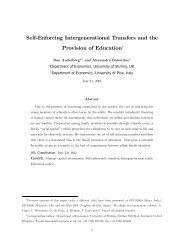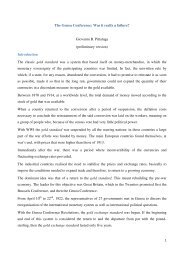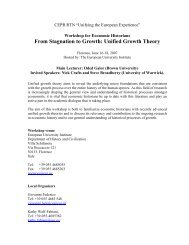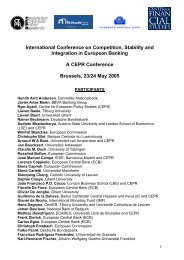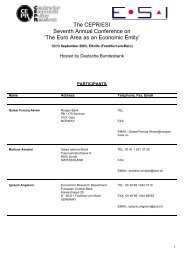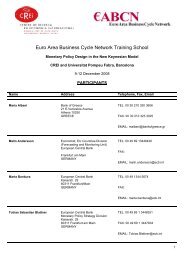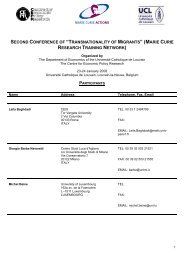MARKET STRUCTURE AND ENTRY: WHERE'S THE BEEF? - CEPR
MARKET STRUCTURE AND ENTRY: WHERE'S THE BEEF? - CEPR
MARKET STRUCTURE AND ENTRY: WHERE'S THE BEEF? - CEPR
You also want an ePaper? Increase the reach of your titles
YUMPU automatically turns print PDFs into web optimized ePapers that Google loves.
etween rival outlets and the random effect ( μ iRIVAL)<br />
is positive and significant. Note that<br />
the introduction of unobserved heterogeneity drives the coefficient of rival outlets in S(.),<br />
the market size function, into insignificance (p-value 0.165). As we cannot reject the Null<br />
of no unobserved heterogeneity, we conclude that BK does indeed use rival outlets to<br />
update its beliefs of market size.<br />
We then estimate the model assuming that unobserved heterogeneity enters in a<br />
linearly separable way (i.e., as part of the fixed costs of entry) and present the results in<br />
column (3). The statistical significance of coefficients is almost uniformly weaker than<br />
in columns (1) and (2). Estimated fixed costs of entry are notably higher (4.17) than<br />
before. The coefficient of the random effect (s.e.) is 0.907 (0.937), and the coefficient of<br />
existing rival outlets in S(.) 0.069 (0.227). These results, together with our belief that<br />
unobserved heterogeneity is important, if at all, on the demand side rather than on the<br />
cost of entry side lead us to reject this specification in favor the alternatives. Indeed, we<br />
cannot reject the simplest formulation of column (1).<br />
[TABLE VI HERE]<br />
Finally, we explore the learning effect in more detail by allowing the coefficient of<br />
rival outlets in S(.) take different values in markets with own, and no own existing<br />
outlets. The results, reported in Table VI, are mostly in line with those in Table V; the<br />
coefficient on pensioners now becomes significant in column 1. Importantly, they clearly<br />
show that BK learns from McD only if it has no own existing outlets in the market.<br />
5.4. Leader (McD) Results<br />
All McD results are produced using MSL. As with BK, we estimate the model under<br />
standard assumptions about the error term, and also assuming an equi-correlated error<br />
structure. Under the standard assumptions, the follower response is simulated; with an<br />
27



